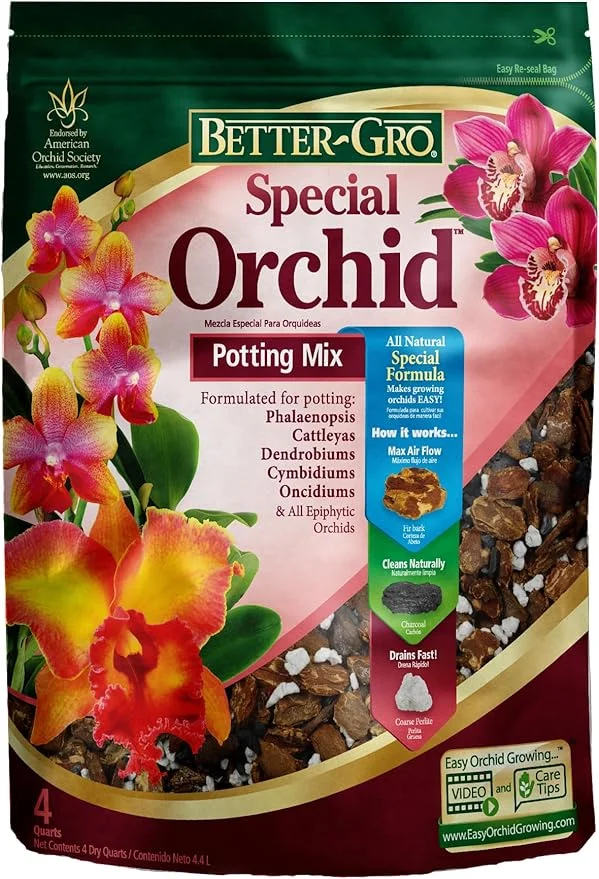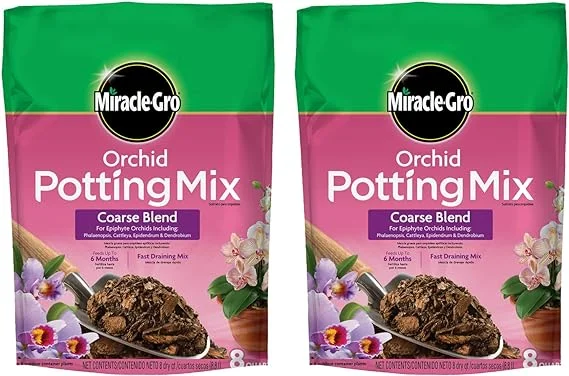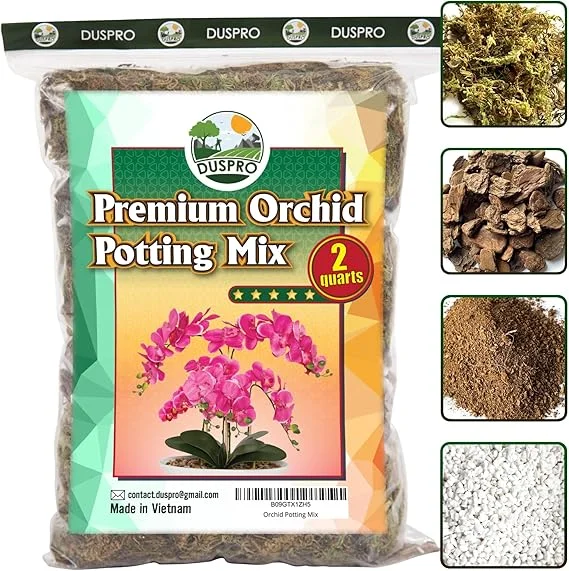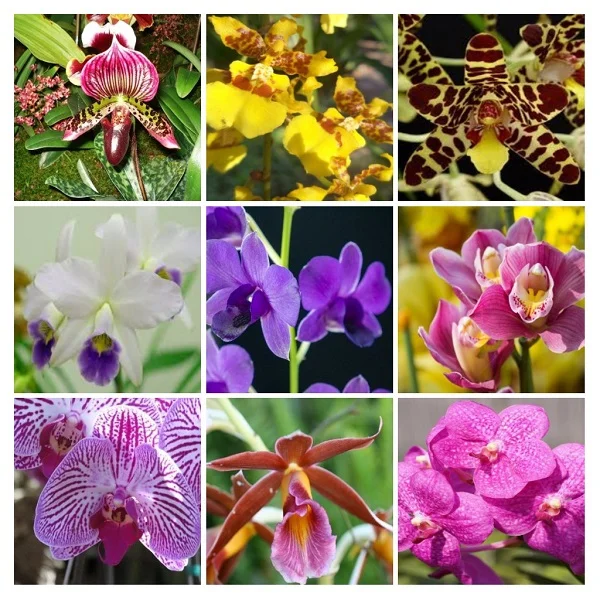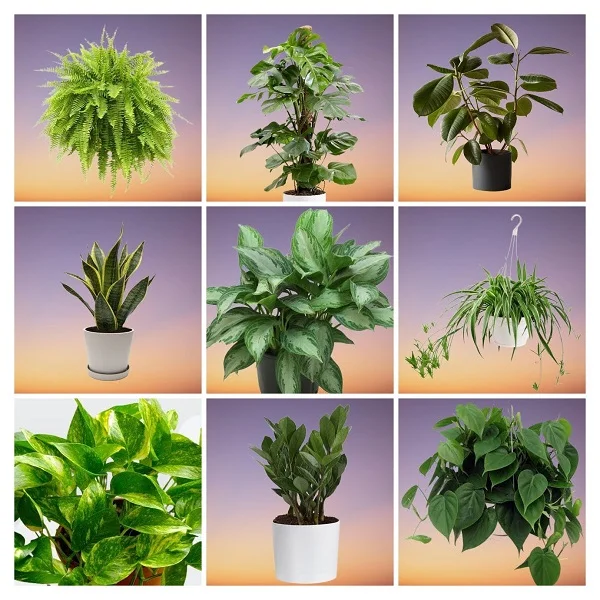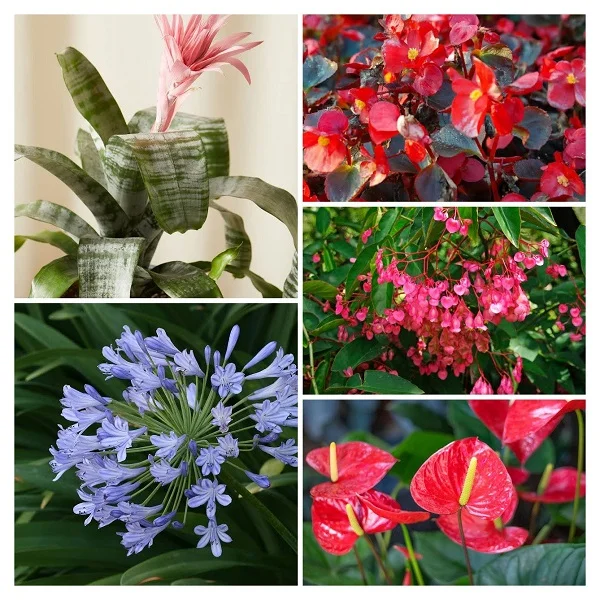Ornamental Pineapple Plant (Ananas Bromeliad) Indoor Care, Propagation & Common Problems
Some links in this post may be affiliate links
Ornamental Pineapple Plant (Ananas Bromeliad) grows best in very bright light with some sunlight, warm and humid conditions and moderately moist, fertile well-drained soils coupled with fortnightly feeding in spring and summer.
Ornamental Pineapple Plant care is easy when given the right growing requirements. In this guide, we cover everything you need to know about caring for and propagating Ornamental Pineapple Plants indoors to help them thrive in your home.
Ananas species are popular Bromeliad varieties which produce a colorful flower-head followed by small aromatic fruits if grown under warm and humid conditions.
Ornamental Pineapples are generally grown for their foliage and beautiful flower-heads. The leaves are sword-shaped and sharp-pointed, growing in a rosette around the stem. They are among the best plants for the front porch or entrance.
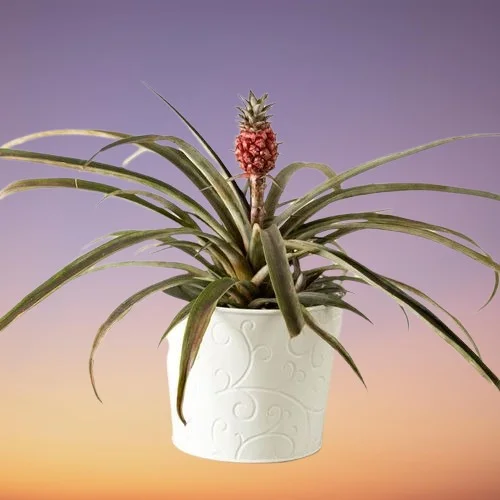
Botanical name: Ananas
Family: Bromeliaceae
Origin
Ananas Bromeliads are native to the tropical regions of Central and South America
Size
The Ornamental Pineapple Plant can grow to a height of about 2 feet and about 4 feet wide.
Flower
Ornamental Pineapples will mature at the age of 1-2 years and it is at maturity when they flower. The display of the flower head is due to the presence of long-lasting showy bracts; true flowers are small and short-lived.
Though the Ananas Bromeliads produces a fruit, the fruit may not be edible. Once the flower-head fades, the rosette of leaves begins to die and is replaced by offsets (pups) at the base which grow into new plants.
Varieties
The most popular Ornamental Pineapple varieties are;
- Ananas bracteatus striatus commonly called Red Pineapple which bears a red fruit.
- Ananas comosus variegatus which bears green and creamy-white stripped leaves and a pinkish-variegated fruit.
The ordinary pineapple, Ananas comosus may be too large and dull to be grown indoors.
Is Ornamental Pineapple Toxic?
No. Ornamental Pineapple Plant are considered non-toxic to humans and pets. They are among the pet-safe houseplants perfect for a home with children, cats, dogs and other pets. However, the leaves bear short spines which may cause physical injury if handled with bare hands. Always wear gloves when handling these plants to prevent injury.
Where to Buy
If you are looking to acquire Ornamental Pineapples for your collection, you may obtain these plants online from Etsy (Link to Etsy).
Ornamental Pineapple Plant Care Indoors
To care for Ornamental Pineapples indoors, provide very bright light with 6-8 hours of direct sunlight, warmth of 18-270C, humidity of 50-55% and moderately moist, rich, well-drained orchids potting soils coupled with fortnightly feeding in spring and summer.
Ananas Bromeliad requires regular pruning of the dead leaves to provide adequate space for the pups growing at the base of the plant. Repotting is only necessary when it outgrows its pot. Keep reading for more on these growing conditions and how to achieve them.
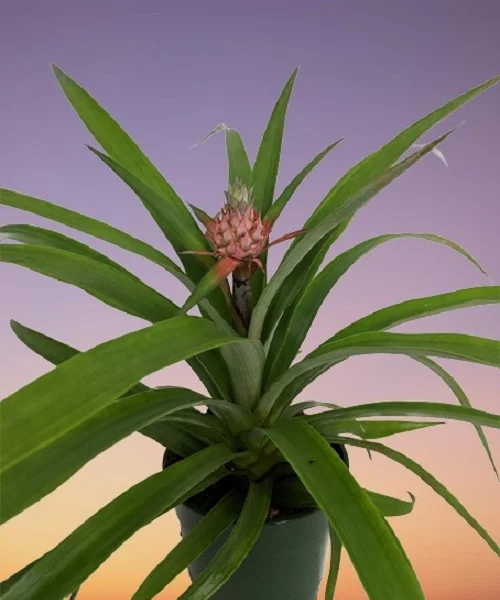
Watering
How often should I water my Ornamental Pineapple Plant?
Water your Ornamental Pineapple Plant liberally in spring and summer and allow the top 2-3 inches of soil to dry out between waterings. Keep the soil moderately moist and avoid overwatering as it can result in rotting and yellowing.
Decrease watering in the cold period to maintain the soil barely moist because growth is minimal at this time. However, do let it dry out completely as it can cause wilting and droopy leaves.
Use only chlorine-free water as it is sensitive to chlorine and other chemicals that may be dissolved in water. Water with room-temperature water as it can reduce vibrancy.
Avoid soggy soil as it can lead to root-rot and eventual death of the plant. Ensure there is good air circulation for your Ananas Bromeliads to discourage pests and diseases infestation.
Light Requirements
Do Ornamental Pineapples need sunlight?
Yes. Ornamental Pineapples flourish in very bright light with 6-8 hours of direct sunlight to promote flowering. However, protect it from hot midday sunshine as it may cause scorching of the leaves.
If the natural lighting is not adequate, consider investing in a grow light to supplement it as too little light can result in stunted growth and yellowing of leaves.
Regularly rotate the pot to ensure that the plant receives light on all sides for a balanced growth.
Temperature & Humidity
Ornamental Pineapples flourish in a warmth of 18-270C. Temperatures outside this range will negatively affect growth of the plant; reduced growth and wilting leaves.
Ananas Bromeliads prefer a humidity of 50-55%. If the humidity is too low, the plant will respond with brown leaf tips and edges. To increase humidity, group the plants together, set the pot on a wet pebble tray or use a cool mist humidifier. Maintain good air flow to discourage fungal diseases.
Potting Medium
The best potting medium for Ornamental Pineapples should be rich, loose, free-draining bark soil to prevent it from getting soggy while providing the required nutrients. Most Orchid potting mixes are perfect for these plants.
Feeding
Feed your Ornamental Pineapple with a liquid fertilizer (foliar feed) every 2 weeks in spring and summer to boost a healthy growth.
Do not feed in fall and winter as growth is minimal thus it can lead to fertilizer burn which is indicated by reduced growth and brown leaf tips.
Regularly get rid of excess salts by running a stream of water through the soil until it drains out through the drainage hole. Allow it to run for 5-10 minutes to leach out as much salt as possible.
Repotting
Repot your Ornamental Pineapple Plant in the beginning of the growing season (spring to early summer), only when it has outgrown its pot. Use a pot 1 size larger than the current one as it grows slowly. Ensure that the pot has a drainage hole and the soil is fast-draining to avoid rotting and loss of the plant.
Pot the Ananas Bromeliads in a shallow, heavy pot to prevent it from toppling over as it can become top-heavy. In addition provide support to help keep it upright. Check out these Ceramic Pots with drainage holes on Amazon.
Pruning
Pruning Ornamental Pineapples entails removal of dead leaves to keep the plant neat and tidy and to allow adequate room for the new plants (pups) to grow.
Remove the dead foliage by cutting at the base with a clean, sharp knife or with a sharp, clean pair of pruning scissors. Keep in mind that the leaves have sharp spines which can cause injury; wear gloves when handling.
Ornamental Pineapple Plant Propagation
Ornamental Pineapple Plant propagation is best done from offsets (pups) appearing at the base of the plant. They can also be propagated from the leafy crown which can be rooted either in water or in soil.
(A) Propagating Ornamental Pineapple Plant from pups
As the plant matures, small baby plants (pups or offsets) grow at its base. This is the best propagation method. New roots should appear in 2-4 weeks.
1. Growing Ornamental Pineapple Plant from pups
- When the Ornamental Pineapple offset (pup) is several months old or 1/3 to 1/2 the height of mother plant, seperate it from the mother plant.
- Ensure the offset (pup) has some roots attached to it. Plant the offset (pup) shallowly in loose, free-draining bark soil.
- Pot it in a shallow, heavy pot to prevent it from toppling over as it can become top-heavy.
- Make sure that the bromeliad is well supported to prevent it from toppling over as it can become top-heavy.
- Place the set up in a warm, brightly-lit place until the new plant is well established after which you can begin routine care.
(B) Propagating Ornamental Pineapple Plant from leafy crown
The Pineapple top leafy crown can be rooted either in water or in soil. Rooting occurs in 3-6 week.
How to prepare the leafy crown;
- Cut off the crown (leafy top) of the fruit.
- Remove a few lower leaves to expose the base.
- Let it dry for 1–2 days to prevent rotting.
- Once dry, root the crown in water or soil.
2. Rooting Pineapple leafy crown in water
- Submerge the base of the crown in a jar of water. Change the water every 5-7 days.
- Position the set up in bright indirect light and wait for roots to develops.
- Transfer the plant to moist, well-draining soil once the roots are 2 inches long.
- Keep the soil slightly moist until the plant is well established.
- Once the new plant is well established you may begin routine care.
3. Rooting Pineapple leafy crown in soil
- Plant directly in moist, well-draining soil.
- Place the set up in bright indirect light and wait for roots to develop.
- Maintain the soil slightly moist until the plant is well established.
- When the new plant is well established you can begin normal routine care.
Read more on how to propagate Bromeliads from Pups (Rooting Bromeliad pups).
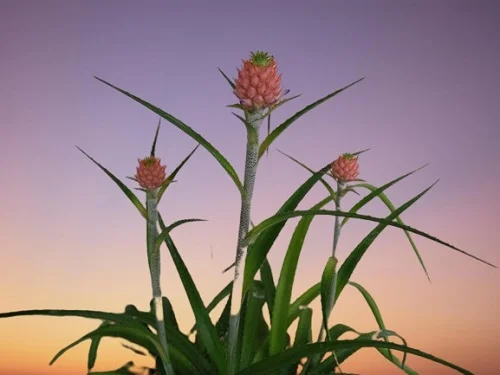
Ornamental Pineapple Plant Problems & Remedies
Ornamental Pineapples (Ananas Bromeliads) common problem are plant dying, yellow leaves, drooping leaves, brown leaf tips, pests and diseases among others. Keep reading for more on these problems and theier solutions.
Plant dying
Why is my Ornamental Pineapple Plant dying?
Ornamental Pineapple Plant is dying due to two possible reasons; either age or root-rot disease.
1. Age: If the plant has flowered, then rotting and death of rosette which bore flower-stalk is a natural process. This happens to give room for the new plants (pups) which grow at the base of the plant.
Remove the dead foliage by cutting at the base with a clean knife or a pair of scissors to create room for the growth of the pups.
2. Root-rot: If the plant has not flowered, then root-rot which is enhanced by soggy soil. The disease is characterized by yellowing and wilting of the leaves which is rapidly followed by browning and plant collapse.
How to fix it
- Carefully slip the plant out of its pot and inspect the roots; brown-black mushy roots indicate root-rot.
- Trim the rotten roots and treat the healthy roots with a copper-based fungicidal solution as recommended by the manufacturer.
- Repot the plant in fresh soil and a fresh pot. Use a pot with a drainage hole and fast-draining soil to prevent it from getting soggy.
- Place the plant in very bright light and stop watering for a few days to give the plant enough time to recover.
Yellow leaves
Some of the causes of yellow leaves on Ornamental Pineapples are too little light, soggy soil, inconsistent watering, drafts, nutrients deficiency or aging.
How to fix it
Too little light: Position the plant in very bright light with 6-8 hours of direct sunlight or use a grow light if you do not have enough light in your home.
Soggy soil: Use well-draining orchids soil and a pot with a drainage hole.
Inconsistent watering: Water when the top 2-3 inches of soil feel dry to the touch but do not allow the soil to dry out completely.
Drafts: Keep the plant away from sources of drafts like hot air vents, AC units, hot surfaces, windy doors among others.
Nutrients deficiency: Feed the plant every 2-3 weeks in spring and summer with an orchids fertilizer.
Aging: This is a natural process. As the lower leaves mature, they turn yellow, brown and eventually die.
Drooping leaves
Drooping leaves on Ornamental Pineapples are caused by drafts, underwatering, soggy soil or pest infestations.
How to fix it
Drafts: Keep the plant away from sources of drafts like AC units, windy doors and windows, hot air vents, heat sources among others.
Underwatering: Do not water on a schedule. Water when the top 2-3 inches of soil dry out but do not allow the soil to dry out completely.
Soggy soil: Use well-draining soil and a pot with a drainage hole.
Pest infestations: Regularly inspect the plant for the pests and carry out timely control measures.
Brown leaf tips
Brown leaf tips on Ornamental Pineapple Plant are caused by dry air, underwatering or salts buildup.
How to fix it
Dry air: To raise humidity, set the pot on a wet pebble tray, use a cool mist humidifier or group the plants together.
Underwatering: Water when the top 2-3 inches of soil dry out but do not let the soil dry out completely.
Salts buildup: Flush out accumulated salts by running a stream of water through the soil until it drains through the drainage hole.
Pests
Common pests on Ornamental Pineapple Plant are scales and mealybugs which are common in dry, hot conditions.
How to fix it
- Isolate the affected plant to prevent spread to other plants.
- Treat the plant with neem oil or insecticidal soap. Make sure to follow the manufacturers, directions.
- Regularly check underneath and between the leaves for these pests and carry out timely control measures.
- Maintain the plant well pruned and raise humidity to minimize the pest infestations.
Conclusion
Ornamental Pineapple Plants (Ananas Bromeliads) are stunning, low-maintenance houseplants that add a tropical touch to any indoor space. With the right care, they will reward you with beautiful foliage and even decorative pineapples.
Frequently Asked Questions
1. How much sunlight does Ornamental Pineapple need?
Ornamental Pineapple thrives in bright, indirect light and needs at least 6-8 hours of sunlight daily.
2. How often should I water my Ornamental Pineapple Plant?
Do not water on a schedule. Water when the top 2-3 inches of soil are dry. Avoid overwatering to prevent root rot.
3. Why isn’t my Ornamental Pineapple Plant producing fruit?
Your Ornamental Pineapple Plant may need more sunlight or phosphorus-rich fertilizer to encourage fruiting.
4. How long does an Ornamental Pineapple Plant live?
Typically, an Ornamental Pineapple Plant lives 3–5 years but produces pups that extend its life cycle.
5. Can I grow an Ornamental Pineapple Plant from a store-bought pineapple?
Yes, You can propagate the top, but it may take years to produce fruit.
You liked it? Share on social media.
Related Content
Amazon Associates Disclosure
Homeplantsguide.com is a participant in the Amazon Services LLC Associates Program, an affiliate advertising program designed to provide a means for sites to earn advertising fees by advertising and linking to amazon.com.
